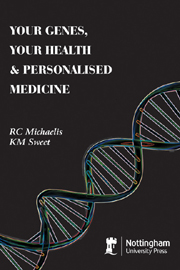Book contents
- Frontmatter
- Contents
- INTRODUCTION
- 1 UNDERSTANDING THE MEANS BY WHICH OUR GENES INFLUENCE OUR HEALTH
- 2 THE MECHANISM WHEREBY A GENE MAKES ITS PROTEIN
- 3 UNDERSTANDING THE PRINCIPLES OF INHERITANCE
- 4 USING YOUR FAMILY HISTORY INFORMATION TO PREDICT YOUR RISK FOR SPECIFIC DISEASES
- 5 USING GENETIC TESTING TO MAINTAIN YOUR HEALTH AND PERSONALISE YOUR MEDICAL CARE, NOW AND IN THE FUTURE
- 6 MAKING THE DECISION WHETHER OR NOT TO HAVE GENETIC TESTING, AND INTERPRETING THE RESULTS OF TESTS YOU CHOOSE TO HAVE PERFORMED
- 7 NUTRIGENOMICS AND EPIGENETICS: THE EFFECTS OUR DIET, ENVIRONMENT AND LIFESTYLE HAVE ON OUR GENES AND PROTEINS
- EPILOGUE AND USEFUL INTERNET RESOURCES
- INDEX
3 - UNDERSTANDING THE PRINCIPLES OF INHERITANCE
- Frontmatter
- Contents
- INTRODUCTION
- 1 UNDERSTANDING THE MEANS BY WHICH OUR GENES INFLUENCE OUR HEALTH
- 2 THE MECHANISM WHEREBY A GENE MAKES ITS PROTEIN
- 3 UNDERSTANDING THE PRINCIPLES OF INHERITANCE
- 4 USING YOUR FAMILY HISTORY INFORMATION TO PREDICT YOUR RISK FOR SPECIFIC DISEASES
- 5 USING GENETIC TESTING TO MAINTAIN YOUR HEALTH AND PERSONALISE YOUR MEDICAL CARE, NOW AND IN THE FUTURE
- 6 MAKING THE DECISION WHETHER OR NOT TO HAVE GENETIC TESTING, AND INTERPRETING THE RESULTS OF TESTS YOU CHOOSE TO HAVE PERFORMED
- 7 NUTRIGENOMICS AND EPIGENETICS: THE EFFECTS OUR DIET, ENVIRONMENT AND LIFESTYLE HAVE ON OUR GENES AND PROTEINS
- EPILOGUE AND USEFUL INTERNET RESOURCES
- INDEX
Summary
Inheritance Of Genetic Factors Through The Generations
In order to understand how we inherit the genetic factors that influence our risk for diseases, you need to understand a little bit about how we use chromosomes to pass our genes down to our children. Human DNA is divided into 46 separate pieces, called chromosomes. Our chromosomes are arranged in 23 pairs; the autosomes are referred to as chromosomes 1-22, and the sex chromosomes are the X and Y. Males and females both have 22 pairs of autosomes. In addition, females have two X chromosomes for their sex chromosome pair, while males have an X and a Y. Each chromosome contains a number of genes; human chromosomes range in size from the Y chromosome, which contains approximately 322 genes, to chromosome 1, which contains approximately 2,800 genes.
Each member of a chromosome pair contains the same set of genes (except X and Y). When we make sperm or eggs, we package 23 chromosomes—one from each pair—into each sperm or egg. Then, when a sperm and egg combine during fertilisation, the child ends up with the 46 chromosomes he/she needs to develop properly. This means that we possess two copies of each of our genes (except males' X and Y genes), but we only pass down one copy of each of our genes to each of our children.
- Type
- Chapter
- Information
- Your Genes, Your Health and Personalised Medicine , pp. 43 - 60Publisher: Nottingham University PressPrint publication year: 2011



